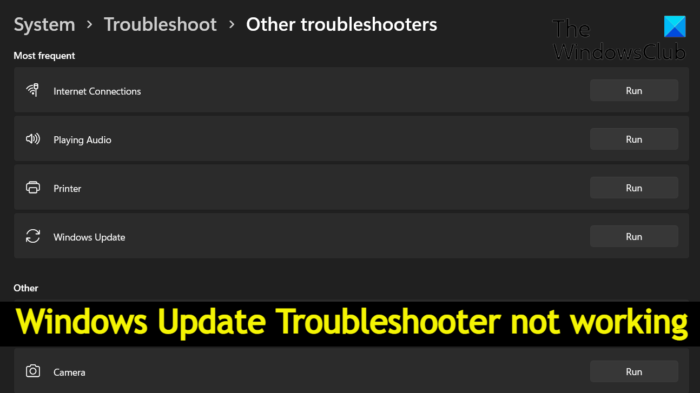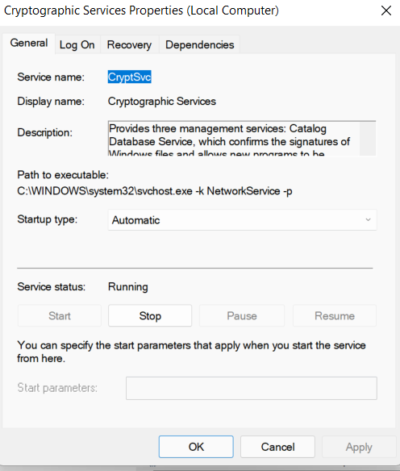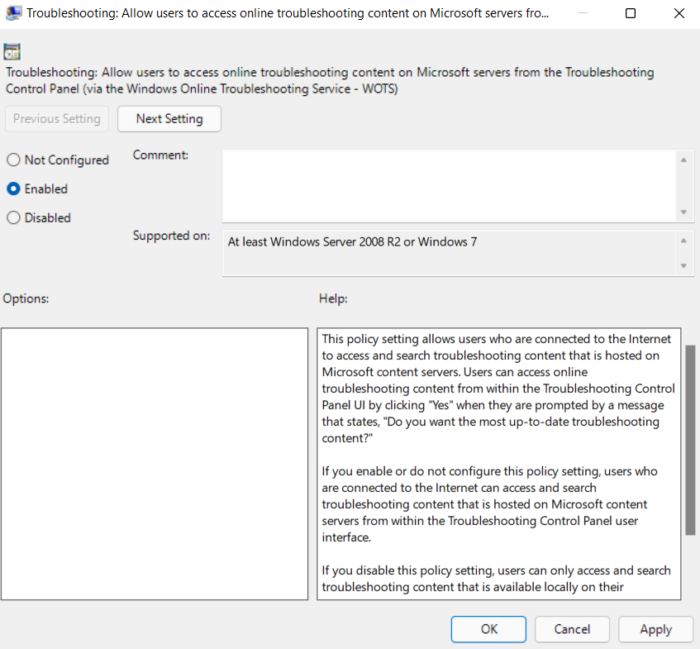Some users have noticed that when they try to use the Windows Update Troubleshooter to fix Windows Update problems, it does not work as intended. It may remain stuck on Resolving problems or Checking for pending restart. If you face this issue, this post suggests ways to resolve it. Running the Windows Update Troubleshooter is one of the best ways to eliminate any Windows update issues. Considering this, it’s crucial to get rid of the problem in question as soon as possible.

Why is Windows Update Troubleshooter not working?
One of the major reasons why Windows Update Troubleshooter is not working on your system is a corrupted user profile or system files. If the Cryptographic Service under the Service Manager is disabled, you will most likely face the problem. The issue can also occur due to temporary files. Now that you have a basic understanding of the different reasons why Windows Update Troubleshooter is not working on your system, let’s check out how to eliminate them.
Windows Update Troubleshooter not working
If Windows Update Troubleshooter is taking forever & is stuck on resolving problems or at checking for pending restart, here are some suggestions that will help you:
- Restart system and check connection
- Run System File Checker
- Enable Cryptographic Service
- Change the Local Group Policy settings
- Login as Administrator
- Run Disk Cleanup
- Check Log files.
Now, let’s check out all these solutions in detail.
Windows Update Troubleshooter stuck on Resolving problems or Checking for pending restart
1] Restart the system and check the connection
First, restart your system and check if it solves the problem. As it turns out, a temporary Windows glitch is one of the primary reasons behind the problem. And the best thing you can do in this situation is to restart your system.
Additionally, make sure you are connected to an active internet connection. As you must know, Windows Update Troubleshooter requires an internet connection to resolve all the issues related to Windows Update. So, connect your system to an active internet connection and check if it solves the problem.
2] Run System File Checker
As mentioned, the problem is mainly caused due to corrupted system files. In this situation, you can run System File Checker, aka SFC scan, to get rid of the problem. Below are the steps you need to run the SFC scan on Windows 11/10.
- To begin with, open Command Prompt in the administrator mode.
- In this space provided, type sfc /scannow and press the enter key.
The process will take around 10-15 minutes, and it will examine all the system files and replace the corrupted ones. Once done, restart your system and try to rerun Windows Update Troubleshooter. Check if the problem is fixed or not. If not, try the next solution.
3] Enable Cryptographic Service

You next thing you should make sure of is that the Cryptographic Service is enabled under the Service Manager. If this isn’t the case, you will most likely face the problem in question. So, here are the steps you need to follow to enable Cryptographic Service.
- Open the Start Menu, type and enter Services.
- Locate Cryptographic Services, right-click on it.
- From the context menu, choose the Properties option.
- Click on the drop-down present next to Startup type and choose Automatic.
- Click on the Start option present under Service status.
- Now, click on Apply to save the changes.
Restart your system and check if you are still facing the problem.
4] Change the Local Group Policy settings

You can configure the Local Group Policy settings to fix the problem as well. Here’s how it’s done.
- Open the Run dialogue box using Windows + R shortcut key.
- Type gpedit.msc and press enter.
- In the Local Group Policy Editor, navigate to the following location, Computer Configuration > Administrative Templates > System > Troubleshooting and Diagnostics > Scripted Diagnostics.
- Right-click on the first entry present under Scripted Diagnostics and choose the Edit option.
- Check the Enabled option, and click on Apply.
- Repeat the same process with the other two entries as well.
Once done, restart the system and check for the problem.
See: How to run Windows Troubleshooters from the command line
5] Login as Administrator
The problem has mainly seemed to occur with users who were not using the Administrator account. So, use Windows Update Troubleshooter when logged on as an administrator user.
See: Online troubleshooter to fix Windows Update Errors
6] Run Disk Cleanup
As mentioned, the problem can occur due to temporary files stored on your system. To get rid of the issue you can run Disk Cleanup.
Read: I was unable to run the Windows Update diagnostic
7] Check Log files
The troubleshooting reports, logs & other data are saved in the following locations:
-
%LocalAppData%\Diagnostics : It contains folders for the previously run troubleshooter.
-
%LocalAppData%\ElevatedDiagnostics : It contains folders for each troubleshooter which was Run as Administrator.
-
Windows Logs/Application
-
Applications and Services Logs/ Microsoft/ Windows/ Diagnosis-Scripted/ Admin
-
Applications and Services Logs/ Microsoft/ Windows/ Diagnosis-ScriptedDiagnosticsProvider/ Operational
-
Applications and Services Logs/ Microsoft/ Windows/ Diagnosis-Scripted/ Operational
See if anything there helps you.
TIP: See this post if you receive An unexpected error has occurred, The troubleshooting wizard can’t continue message with error codes 0x803c010a, 0x80070005, 0x80070490, 0x8000ffff, etc.
How do I manually troubleshoot Windows updates?
It’s very easy to troubleshoot a Windows Update problem manually. To begin with, open the Windows settings, and choose Troubleshoot option present under System. Open Other troubleshooters in the following window. Click on the Run option present next to Windows Update.